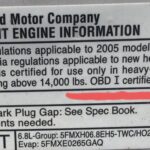Understanding OBD2 Parameter IDs (PIDs) is crucial for effective vehicle diagnostics. These standardized codes provide valuable insights into the performance of various vehicle systems. This guide delves into common Obd2 Pid Definitions, explaining their meaning and significance in troubleshooting car problems.
Common OBD2 PID Definitions and Their Uses
OBD2 PIDs represent specific data points measured by the vehicle’s onboard computer. Accessing these PIDs with an OBD2 scanner allows mechanics and car enthusiasts to monitor engine performance, emissions, and other crucial parameters. Here are some key OBD2 PID definitions:
Engine Speed (RPM)
This PID measures the crankshaft’s rotational speed in revolutions per minute, providing a fundamental indicator of engine activity.
Vehicle Speed
This PID reflects the speed at which the vehicle is traveling, often derived from the transmission output or wheel speed sensors.
Spark Advance
Measured in degrees of crankshaft rotation, this PID indicates the timing of the spark ignition relative to the piston’s position. Proper spark advance is vital for optimal engine power and efficiency.
Intake Air Temperature (IAT)
The IAT sensor measures the temperature of the air entering the engine. This data is critical for calculating air density and adjusting the air/fuel mixture accordingly.
Mass Air Flow (MAF)
The MAF sensor quantifies the amount of air entering the engine, enabling the engine control unit (ECU) to calculate the correct fuel delivery for optimal combustion.
Throttle Position (TPS)
This PID represents the position of the throttle plate, indicating how much air is allowed into the engine.
Oxygen Sensor (O2S)
O2 sensors measure the oxygen content in the exhaust gases, providing feedback for fuel mixture adjustments and catalytic converter efficiency monitoring. Readings are often presented as voltage signals. Common designations include B1S1 (Bank 1, Sensor 1), B2S1 (Bank 2, Sensor 1), etc.
Short Term Fuel Trim (STFT)
STFT reflects short-term adjustments made to the fuel mixture based on O2 sensor feedback. It indicates how the ECU is compensating for deviations from the ideal air/fuel ratio. Like O2 sensors, readings are identified by bank and sensor number (e.g., STFT B1S2).
Run Time
This PID tracks the engine’s running time since it was last started.
Commanded EGR
This PID displays the desired position of the Exhaust Gas Recirculation (EGR) valve, expressed as a percentage.
Commanded EVAP
This PID represents the commanded state of the Evaporative Emission Control (EVAP) system, often indicating whether the purge valve is open or closed.
Fuel Level
This PID provides information on the remaining fuel level in the tank, usually expressed as a percentage.
Warm-up DTC Clear
This parameter counts the number of engine warm-up cycles since Diagnostic Trouble Codes (DTCs) were last cleared.
Distance Since Cleared Diagnostic Codes
This PID indicates the distance driven since the last DTC clearing.
Evaporative Emissions System Vapor Pressure (EVAP_VP)
This PID measures the pressure within the fuel tank’s EVAP system.
Barometric Pressure (BARO)
This PID provides the current atmospheric pressure, used for various calculations, including those related to the intake air.
Conclusion
Understanding OBD2 PID definitions empowers you to effectively diagnose vehicle issues. By using an OBD2 scanner and interpreting the data provided by these PIDs, you can gain valuable insights into the performance and health of your vehicle. This knowledge is essential for both professional mechanics and car owners seeking to maintain and repair their vehicles.

